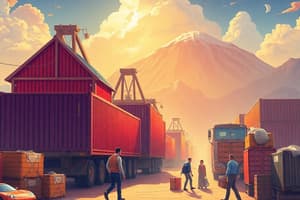Podcast
Questions and Answers
What is a tariff?
What is a tariff?
A tax levied when a good is imported.
What type of tariff is levied as a fixed charge for each unit of goods imported?
What type of tariff is levied as a fixed charge for each unit of goods imported?
- Quota
- Ad valorem tariff
- Voluntary export restraint
- Specific tariff (correct)
What type of tariff is levied as a fraction of the value of the imported goods?
What type of tariff is levied as a fraction of the value of the imported goods?
- Quota
- Voluntary export restraint
- Specific tariff
- Ad valorem tariff (correct)
What happens to Home consumers' demand when the price of a good increases?
What happens to Home consumers' demand when the price of a good increases?
What is the relationship between Home import demand and Foreign export supply at world equilibrium?
What is the relationship between Home import demand and Foreign export supply at world equilibrium?
What is the net cost of a tariff for the importing country?
What is the net cost of a tariff for the importing country?
What does the rate of effective protection measure?
What does the rate of effective protection measure?
What is the effect of a tariff on the volume of trade?
What is the effect of a tariff on the volume of trade?
What happens to overall national welfare when a tariff is applied by a small importing country?
What happens to overall national welfare when a tariff is applied by a small importing country?
Which group is considered a winner in the importing country when tariffs are imposed?
Which group is considered a winner in the importing country when tariffs are imposed?
Who are the primary losers when tariffs are implemented by an importing country?
Who are the primary losers when tariffs are implemented by an importing country?
In terms of consumer impact, what is the effect of tariffs on the consumers in the exporting country?
In terms of consumer impact, what is the effect of tariffs on the consumers in the exporting country?
Which of the following statements about the impact of tariffs is accurate regarding domestic producers in the importing country?
Which of the following statements about the impact of tariffs is accurate regarding domestic producers in the importing country?
What is the purpose of ad valorem tariffs?
What is the purpose of ad valorem tariffs?
How does a tariff affect consumer surplus in the importing country?
How does a tariff affect consumer surplus in the importing country?
What happens to the Home producers' supply when the price of a good increases?
What happens to the Home producers' supply when the price of a good increases?
What is the net effect of a tariff on the volume of trade?
What is the net effect of a tariff on the volume of trade?
What describes the relationship at world equilibrium between Home import demand and Foreign export supply?
What describes the relationship at world equilibrium between Home import demand and Foreign export supply?
Which of the following best describes producer surplus?
Which of the following best describes producer surplus?
What is the primary welfare effect of a tariff on Home producers?
What is the primary welfare effect of a tariff on Home producers?
How do voluntary export restraints (VERs) typically affect exporting countries?
How do voluntary export restraints (VERs) typically affect exporting countries?
What happens to the demand for imports when a small country imposes a tariff?
What happens to the demand for imports when a small country imposes a tariff?
Which of the following components is NOT included in the calculation of net costs of a tariff?
Which of the following components is NOT included in the calculation of net costs of a tariff?
In the context of effective protection, what does the formula typically measure?
In the context of effective protection, what does the formula typically measure?
Which of the following reflects the effect of a tariff on terms of trade?
Which of the following reflects the effect of a tariff on terms of trade?
What does the effective protection rate indicate when both intermediate and final goods are imported?
What does the effective protection rate indicate when both intermediate and final goods are imported?
What is the primary purpose of an import quota?
What is the primary purpose of an import quota?
How does an export subsidy affect prices in exporting and importing countries?
How does an export subsidy affect prices in exporting and importing countries?
What is a voluntary export restraint?
What is a voluntary export restraint?
What is the consequence of imposing an import quota on a good?
What is the consequence of imposing an import quota on a good?
What will happen to the domestic value added if the nominal tariff on imported suits is increased?
What will happen to the domestic value added if the nominal tariff on imported suits is increased?
Flashcards are hidden until you start studying
Study Notes
Partial Equilibrium Analysis of Tariffs
- A tariff is a tax levied on imported goods.
- Specific tariffs are applied as a fixed charge per unit of imported good.
- Ad valorem tariffs are applied as a percentage of the imported goods' value.
Deriving Home's Import Demand Curve
- As prices increase, domestic consumers demand less and producers supply more.
- This results in a decreased demand for imports.
Deriving Foreign's Export Supply Curve
- As prices increase, foreign producers supply more and consumers demand less.
- This results in an increased supply available for export.
World Equilibrium
- The world price occurs where home import demand equals foreign export supply.
- This equilibrium represents the point where world demand equals world supply.
Costs and Benefits of a Tariff for the Importing Country
- Consumers in the importing country face higher prices due to the tariff, resulting in a loss of consumer surplus.
- Domestic producers benefit from the tariff, as they can sell their goods at a higher price, leading to an increase in producer surplus.
- The government collects revenue from the tariff, which is represented by the tariff revenue.
- These costs and benefits are measured using areas on a graph.
Net Welfare Effects of a Tariff
- The welfare effects of a tariff can be separated into efficiency losses and a potential terms of trade gain.
- Efficiency losses occur due to the distortion of the market caused by the tariff, reducing economic efficiency.
- When the importing country is large enough, the tariff can lead to a terms of trade gain, as the world price falls. However, the overall welfare effect of the tariff is still negative.
The Theory of Tariff Structure
- The rate of effective protection evaluates the tariff structure's impact on value added per unit produced in each industry.
- It considers both intermediate and final imported goods.
The Rate of Effective Protection (Example 1)
- The example explains how to calculate the rate of effective protection, considering the tariff on imported wool.
The Rate of Effective Protection (Example 2)
- The example continues the previous scenario, calculating the rate of effective protection for a suit with imported wool.
Partial Equilibrium Analysis of Tariffs:
- A tariff is a tax levied on imported goods.
- Specific tariffs are levied as a fixed charge per unit of goods imported.
- Ad valorem tariffs are levied as a fraction of the imported goods' value.
Deriving Home's Import Demand Curve and Foreign's Export Supply Curve:
- Home's import demand curve slopes downwards as the price of the good increases; Home consumers demand less, and Home producers supply more.
- Foreign's export supply curve slopes upwards as the price of the good rises; Foreign producers supply more, and Foreign consumers demand less.
World Equilibrium:
- The equilibrium world price is when Home import demand equals Foreign export supply.
Effects of a Tariff:
- A tariff raises the price in the importing country while lowering the price in the exporting country.
- The volume traded declines when a tariff is imposed.
A Tariff in a Small Country:
- When a country is small, a tariff cannot lower the foreign price of the imported good.
- The price of the import rises, and the quantity of imports demanded falls.
Costs and Benefits of a Tariff:
- Consumer surplus is the area under the demand curve and above the price.
- Producer surplus is the area above the supply curve and below the price.
- The net cost of a tariff is the consumer loss minus the producer gain minus the government revenue.
Net Welfare Effects of a Tariff:
- Efficiency losses are represented by the colored triangles.
- A terms of trade gain is represented by the rectangle.
The Rate of Effective Protection:
- The rate of effective protection measures the total effect of the tariff structure on the value added per unit of output in an industry.
- This rate considers both intermediate and final goods imported.
Partial Equilibrium Analysis of Quota:
- A quota is a direct limit on the quantity of a good that can be imported.
- Quotas always raise the domestic price of the imported good.
An Import Quota in Practice:
- The United States has a quota on sugar imports to protect domestic prices.
- The quotas restrict imports of both raw and refined sugar.
Partial Equilibrium Analysis of Export Subsidies:
- An export subsidy is a payment to a firm or individual for exporting goods.
Effects of an Export Subsidy:
- An export subsidy raises prices in the exporting country and lowers them in the importing country.
Case: Europe's Common Agricultural Policy:
- The European agricultural policy has created a massive export subsidy program.
Voluntary Export Restraint:
- A voluntary export restraint (VER) is a quota on trade imposed by the exporting country at the request of the importing country.
A Voluntary Export Restraint in Practice: Japanese Autos:
- In 1979, Japanese car manufacturers agreed to a VER to avoid further trade restrictions imposed by the United States.
Welfare Effects of Voluntary Export Restraints:
- Consumers in the importing country lose, while producers in the importing country gain from VERs.
- Producers in the exporting country lose, while consumers in the exporting country gain from VERs.
Studying That Suits You
Use AI to generate personalized quizzes and flashcards to suit your learning preferences.




